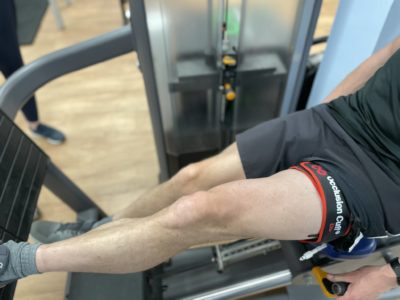Blood Flow Restriction Training
Written by: Nicola Kennedy
Description
Blood flow restriction (BFR) is a safe alternative type of treatment which we use at Elite. The training style involves low intensity exercise through occlusion, (reducing blood flow) enabling the production of similar gains to high intensity training. A cuff is placed on the limb with the appropiate pressure collaborated through the occlusion cuff. The aim is to restrict arterial flow, reducing venous return to the heart and therefore increasing the muscle oxygen demand. This style of training isolates the muscle targeted to work harder. It can be used to both upper and lower limb, placed above the muscle group being worked.
Suitable for patients:
- Immobilised in a cast/brace due to a bone fracture
- Post ligament reconstructions i.e. anterior cruciate ligament
- Restricted to a partial weight-bearing status
- Pre and post joint replacement surgery
- Osteoporosis
BFR training is not suitable for anyone with heart conditions, high blood pressure, bleeding disorders, a history of blood clots or anyone who is pregnant.
Purpose
At Elite we use BFR as an alternative training modality when a patient is unable to load. This could be due to the time in post-operative care, if they have high levels of pain, in the elder patients or early-stage rehabilitation. The main aim is to build on muscle hypertrophy (mass/diameter of the muscle targeted) to assist healing. When a muscle is under metabolic stress, there is a release of hormones, hypoxia and cell swelling.
The idea is that the body is working at 30% of 1 rep max, but due to the occlusion the body is working twice as hard hence the benefits.

Our physiotherapists prescribing your session will advise on what frequency should be used. The pressure setting is usually between 140-180 mmHg. Repetitions and sets and a strict rest time between are set based on your individual ideal load and dependant on your set goal.
Evidence based-practice
This style of training is a useful clinical rehabilitation tool. Low-load BFR training is more effective compared with low-load training. BFR is tolerable and easy to use both in clinic, at home and the gym. It is beneficial to our patient’s rehabilitation as it activates and addresses muscle loss as result of a particular pathology, inactivity or post-surgery.
If you are interested in blood flow restriction training, in a safe guided rehabilitation environment, please call us on 01296 437717 to arrange an appointment
References:
- Centner, C., Wiegel, P., Gollhofer, A., König, D., (2019) ‘Effects of Blood Flow Restriction Training on Muscular Strength and Hypertrophy in Older Individuals: A Systematic Review and Meta-Analysis’. Sports Med. 49(1) pp. 95-108. doi: 10.1007/s40279-018-0994-1
- Erickson, L.N., Lucas, K.C.H., Davis, K.A., Jacobs, C.A., Thompson, K.L., Hardy, P.A., Andersen, A.H., Fry, C.S., Noehren, B.W., (2019) ‘Effect of Blood Flow Restriction Training on Quadriceps Muscle Strength, Morphology, Physiology, and Knee Biomechanics Before and After Anterior Cruciate Ligament Reconstruction: Protocol for a Randomized Clinical Trial’. Phys Ther. 99(8) pp.1010-1019. doi: 10.1093/ptj/pzz062
- Hughes, L., Paton, B., Rosenblatt, B., Gissane, C., Patterson, S.D., (2017) ’Blood flow restriction training in clinical musculoskeletal rehabilitation: a systematic review and meta-analysis’. Br J Sports Med. 51(13) pp. 1003-1011. doi: 10.1136/bjsports-2016-097071
- Lu, Y., Patel, B.H., Kym, C., Nwachukwu, B.U., Beletksy, A., Forsythe, B., Chahla, J., (2020) ‘Perioperative Blood Flow Restriction Rehabilitation in Patients Undergoing ACL Reconstruction: A Systematic Review’.Orthop J Sports Med. 8(3). doi: 10.1177/2325967120906822
- Rolnick, N., and Schoenfeld, B., (2020). ‘Blood Flow Restriction Training and the Physique Athlete: A Practical Research-Based Guide to Maximizing Muscle Size’. Strength and Conditioning Journal. 42(5) pp. 22-36. doi: 10.1519/SSC.0000000000000553



